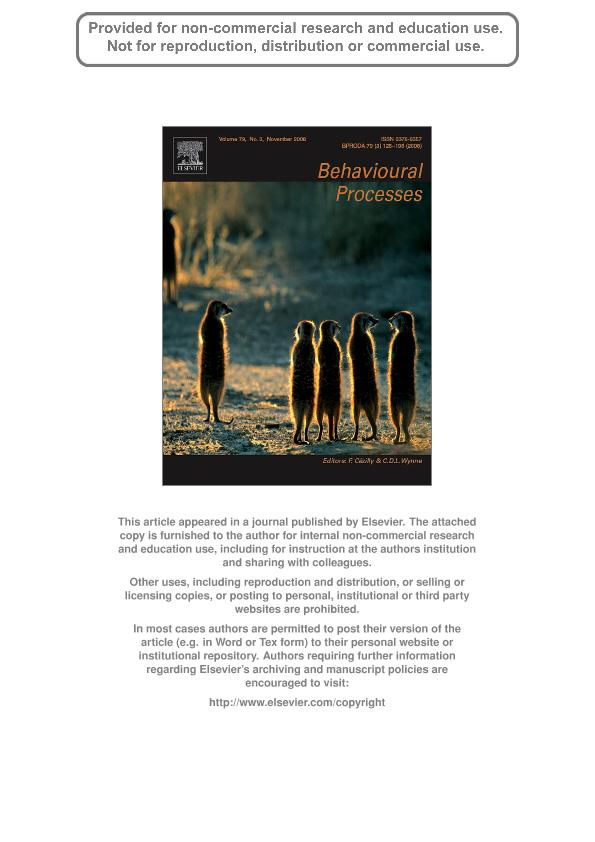Mostrar el registro sencillo del ítem
dc.contributor.author
Pellegrini, Santiago

dc.contributor.author
Lopez Seal, María Florencia

dc.contributor.author
Papini, Mauricio Roberto

dc.date.available
2020-05-08T19:53:08Z
dc.date.issued
2008-11
dc.identifier.citation
Pellegrini, Santiago; Lopez Seal, María Florencia; Papini, Mauricio Roberto; Scaling relative incentive value: Different adjustments to incentive downshift in pigeons and rats; Elsevier Science; Behavioural Processes; 79; 3; 11-2008; 182-188
dc.identifier.issn
0376-6357
dc.identifier.uri
http://hdl.handle.net/11336/104671
dc.description.abstract
Previous research suggests that pigeons and rats show differences in their behavioral adjustments in spaced-trial, incentive-downshift situations. Also, Papini and Pellegrini [Papini, M.R., Pellegrini, S., 2006. Scaling relative incentive value in consummatory behavior. Learn. Motiv. 37, 357–378] and Pellegrini and Papini [Pellegrini, S., Papini, M.R., 2007. Scaling relative incentive value in anticipatory behavior. Learn. Motiv. 38, 128–154] showed that changes in the rat’s lever-pressing performance, runway running, and consumption of sucrose solutions after downshifts in incentive magnitude were a function of the ratio of postshift/preshift incentivemagnitudes. Here, two experiments using a Pavlovian autoshaping procedure studied the adjustment of pigeons and rats to changes in incentive magnitude. In Experiment 1, pigeons received light-food pairings, whereas in Experiment 2, rats received lever-sucrose pairings. As a result,key-pecking and lever-pressing developed in each experiment, respectively. Preshift incentivemagnitudes were downshifted so as to obtain postshift/preshift ratios of 0.125 and 0.25. Pigeons responded during the postshift phase according to the preshift incentive value and independently of the ratio value. However, rats showed ratio constancy, responding during the postshift in accordance with the postshift/preshift ratio, rather thanwith the absolutemagnitudes of either the preshift or postshift incentives. These results support the comparative hypothesis that the mechanisms underlying ratio constancy during incentive downshifts are unique to mammals.
dc.format
application/pdf
dc.language.iso
eng
dc.publisher
Elsevier Science

dc.rights
info:eu-repo/semantics/openAccess
dc.rights.uri
https://creativecommons.org/licenses/by-nc-sa/2.5/ar/
dc.subject
INCENTIVE CONTRAST
dc.subject
INCENTIVE DOWNSHIFT
dc.subject
AUTOSHAPING
dc.subject
WEBER'S LAW
dc.subject.classification
Psicología

dc.subject.classification
Psicología

dc.subject.classification
CIENCIAS SOCIALES

dc.title
Scaling relative incentive value: Different adjustments to incentive downshift in pigeons and rats
dc.type
info:eu-repo/semantics/article
dc.type
info:ar-repo/semantics/artículo
dc.type
info:eu-repo/semantics/publishedVersion
dc.date.updated
2020-05-05T16:07:47Z
dc.journal.volume
79
dc.journal.number
3
dc.journal.pagination
182-188
dc.journal.pais
Países Bajos

dc.journal.ciudad
Amsterdam
dc.description.fil
Fil: Pellegrini, Santiago. Consejo Nacional de Investigaciones Científicas y Técnicas. Oficina de Coordinación Administrativa Houssay. Instituto de Investigaciones Médicas. Universidad de Buenos Aires. Facultad de Medicina. Instituto de Investigaciones Médicas; Argentina
dc.description.fil
Fil: Lopez Seal, María Florencia. Consejo Nacional de Investigaciones Científicas y Técnicas. Oficina de Coordinación Administrativa Houssay. Instituto de Investigaciones Médicas. Universidad de Buenos Aires. Facultad de Medicina. Instituto de Investigaciones Médicas; Argentina
dc.description.fil
Fil: Papini, Mauricio Roberto. Texas Christian University; Estados Unidos
dc.journal.title
Behavioural Processes

dc.relation.alternativeid
info:eu-repo/semantics/altIdentifier/doi/https://www.sciencedirect.com/science/article/abs/pii/S0376635708001873?via%3Dihub
dc.relation.alternativeid
info:eu-repo/semantics/altIdentifier/doi/http://dx.doi.org/10.1016/j.beproc.2008.07.008
Archivos asociados
